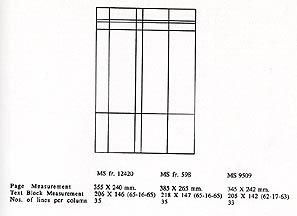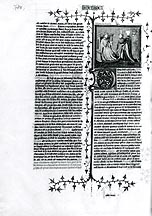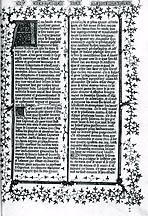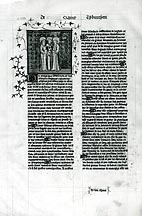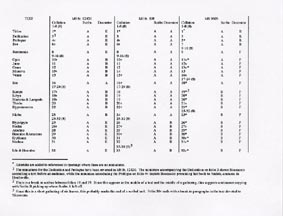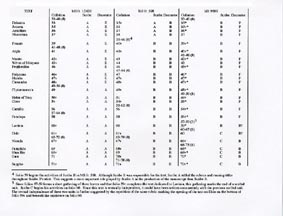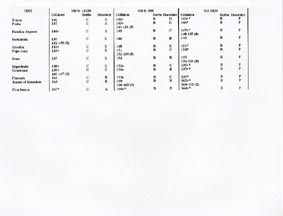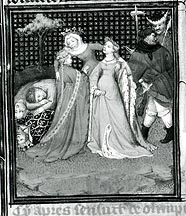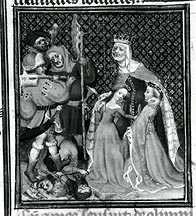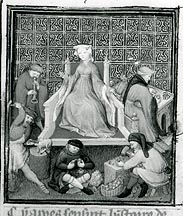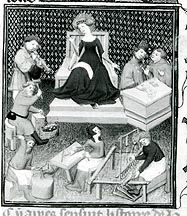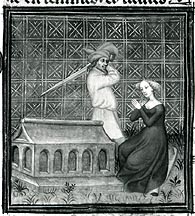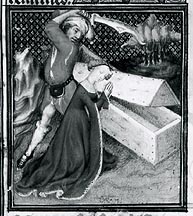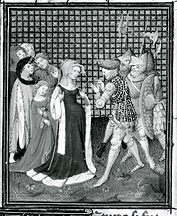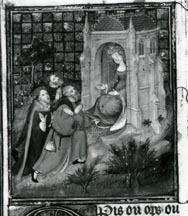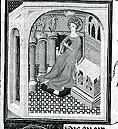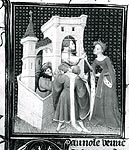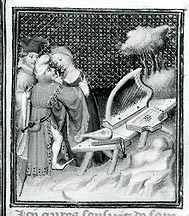The Making of Early Copies of the French Translation
of Boccaccio's De mulieribus claris
An illuminated manuscript
is a nexus of various branches of medieval studies. This insight underlies
many recent studies of late medieval manuscripts.
Derek Pearsall has written: "...palaeography, codicology and manuscript studies
generally are now more than ever before to be seen as an integral part of the
study of literature and literary history, and vice versa. The fact of their interdependence
becomes clearer and clearer as research advances, and the nature of that interdependence
needs to be similarly clarified." Scholars have emphasized the attention
paid by authors like Guillaume de Machaut and Christine de Pizan to the production
of copies of their texts. The traditional disciplinary boundaries separating
studies of the textual and pictorial contents have been broken down: literary
and art historians alike have explored text-image relationships. With the
advent of codicology, the interests of the art historian and palaeographer
have begun
to merge. Art historians have sought to examine the paintings in manuscripts
not in isolation but as part of an integrated study of a book as a totality.
The appreciation of a manuscript as a product of a carefully conceived plan
and of the coordinated activities of different specialists has led historians
of
the medieval book to explore the social and economic contexts involved in
the book industry.
These perspectives inform this present study which will examine the production
of three early copies of a French translation of Boccaccio's De mulieribus
claris. On September 12, 1401, an anonymous translator completed work on
the French version
, entitled Des femmes nobles et renommées. On New Year's day of 1403,
Jacques Rapondi, a Lucchese merchant established in Paris, presented a copy of
the translation to Philippe le Hardi, the duke of Burgundy. In February of 1404,
Jean de la Barre, receveur general des finances in Languedoc and Guyenne, presented
a copy of the same text to Jean de Berry. Both of these copies are currently
preserved in the Bibliothèque nationale in Paris. On the basis of the
Burgundian inventory of 1420, MS fr. 12420 can be identified as the copy given
to Philippe, while the ex libris of the Duke of Berry written by his secretary,
Jean Flamel, appears at the beginning of MS fr. 598 and the signature of Jean
de Berry appears on folio 161. A third early copy of the text is in the Bibliothèque
Royale in Brussels (MS 9509). Although this manuscript appears in inventories
of the Burgundian collection, its date and original ownership are unclear.
Meiss has dated the Brussels' manuscript to between 1410-1415 on the basis
of his assessment
of the style of the miniatures. Although the more limited miniature cycle
of this manuscript distinguishes it from MS fr. 12420 and MS fr. 598, examination
of the manuscript reveals its close association to the other copies.
These manuscripts
are significant for both the intellectual and art historian. They are early
testament to the French interest in the writings of "modern" authors,
especially the works of Boccaccio. The heavy emphasis Boccaccio places
on the mythology and history of the ancient world apparently appealed to
the growing "humanist" interests
within the intellectual circles associated with the French court at the
beginning of the fifteenth-century. Bella Martens pointed to the art historical
importance
of the miniatures in these books in the developing naturalism of early
fifteenth-century French manuscript illumination. She attributed the miniatures
in MS fr. 12420
and MS fr. 598 along with a group of other manuscripts to an artist she
dubbed the Master of 1402. More recent assessments by Millard Meiss and
Patrick de Winter,
while agreeing with Martens on the stylistic importance of the miniatures,
have seen that each manuscript is dominated by a distinct artistic personality. 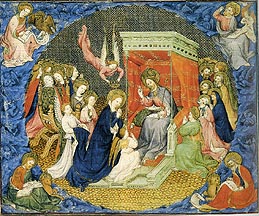 With
the exception of a few miniatures, Meiss has attributed the miniatures
of MS fr. 12420 to an artist he has called the Coronation Master after
a representation
of the Coronation of the Virgin this artist added to a copy of the Golden
Legend (Paris, Bibliothèque nationale, MS fr. 242).
In turn, Meiss used the miniatures of MS fr. 598 as the eponymous manuscript
on which to base the corpus of an artist he named the Master of Berry's
Cleres Femmes. After earlier attributing both manuscripts to the same
group of miniaturists,
de Winter has subsequently come to agree with Meiss's attribution, although
he identifies the principal artist of MS fr. 12420 after this manuscript
as the
Maître du livre Des Femmes nobles et renommées de Philippe
le Hardi. De Winter has distinguished three distinct hands in the miniatures
of MS fr.
598. Meiss has attributed the miniatures of MS 9509 to an artist related
to his Master of Berry's Cleres Femmes.
With
the exception of a few miniatures, Meiss has attributed the miniatures
of MS fr. 12420 to an artist he has called the Coronation Master after
a representation
of the Coronation of the Virgin this artist added to a copy of the Golden
Legend (Paris, Bibliothèque nationale, MS fr. 242).
In turn, Meiss used the miniatures of MS fr. 598 as the eponymous manuscript
on which to base the corpus of an artist he named the Master of Berry's
Cleres Femmes. After earlier attributing both manuscripts to the same
group of miniaturists,
de Winter has subsequently come to agree with Meiss's attribution, although
he identifies the principal artist of MS fr. 12420 after this manuscript
as the
Maître du livre Des Femmes nobles et renommées de Philippe
le Hardi. De Winter has distinguished three distinct hands in the miniatures
of MS fr.
598. Meiss has attributed the miniatures of MS 9509 to an artist related
to his Master of Berry's Cleres Femmes.
The studies, to date, have focused primarily on examinations of the style
and iconography of the miniatures. Little consideration
has been given to other aspects of the making of these books, most
notably
to the
copying of the text and the secondary decoration. These issues will
be the focus of this
paper, which will examine the discrete stages of the production of
the books from the laying out of the page and the scribal work, through
the
secondary
decoration, to the creation of the miniature cycles. What this examination
will reveal is
that the manuscripts are closely linked in each of these stages. The
connections go beyond general similarities based on standardization
of book making
practices. We will see that some of the same scribes and decorators
were active in each
manuscript. Although I agree with Meiss and de Winter that the miniatures
were created by distinct artisans, an assessment of the relationship
of the miniatures
to the text suggests that the miniaturists were not working independently
but worked under the supervision of a planner. The implications of
these connections
between the manuscripts in their various stages of production suggest
that they represent a veritable first edition of this new text.
THE SCRIBAL ACTIVITY
Before the scribes could have begun their work, the lay-out or mise-en-page needed to be defined. All three copies have nearly identical lay-outs, with a two column format and similar ruling patterns. In both MS fr. 12420 and MS fr. 598, there are 35 rows of text per column, while in MS 9509 there are only 33 rows. The measurements of the text blocks in the respective manuscripts although not identical are similar. In laying out the manuscript, it was decided to have allowed between 11 and 14 lines for a miniature and between 4 and 6 lines for an initial to introduce each new text. The type of script to be used also needed to be decided. All three manuscripts are written in the same script, gothica textualis.
The striking similarities in the lay-outs of the three manuscripts
could reflect the standardization of manuscript making practices,
and not necessarily
a direct
relationship in their production. Many of the similarities
noted above can be found in a large number of other books produced
in Paris at
the same time.
Similar
lay-outs are found in copies of texts like the Bible
historiale (e.g. Paris, Bibliothèque nationale,
MS fr. 159), the Livre
des propriétés
des Choses (e.g. Brussels, Bibliothèque royale,
MS 9094), and the Légende
dorée (e.g. Paris, Bibliothèque nationale,
MS fr. 242). 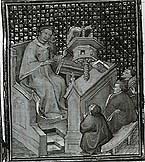 The choice of this mise-en-page for the Boccaccio
text
was probably intended
to place
it in the context of the clerkly tradition of authoritative
texts to which
these
other texts belong. The miniatures introducing the Dedication
and Prologue show Boccaccio dressed as a cleric thereby
attesting
to
the author's
link to the tradition
of Classical and Christian auctores.
The choice of this mise-en-page for the Boccaccio
text
was probably intended
to place
it in the context of the clerkly tradition of authoritative
texts to which
these
other texts belong. The miniatures introducing the Dedication
and Prologue show Boccaccio dressed as a cleric thereby
attesting
to
the author's
link to the tradition
of Classical and Christian auctores.
Closer examination of the scripts of the manuscripts reveals
the work of three distinct scribes. This identification
is based on
three different
criteria: general aspect of the scripts, particular letter
formations,
and general
scribal habits. 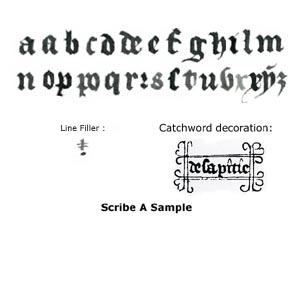 The
general aspect of the script of the scribe here designated
as A is very regular and controlled with the
letters being
comparatively
widely
spaced. Among
the distinguishing letter formations, the descender of
this copyist's "g" generally forms a long,
fluid curve going off to the left. The letter "y" generally
has a faint, hair-line descender trailing down to the left,
and this letter is
characteristically
dotted with a short stroke that ascends from the left to
the right. As a scribal habit, Scribe A frequently fills
the empty
space at
the end
of a
line of text
with a faint vertical stroke crossed by horizontal dashes.
The framing device for catchwords appears
regularly and
is virtually
a
signature for Scribe A's work.
The
general aspect of the script of the scribe here designated
as A is very regular and controlled with the
letters being
comparatively
widely
spaced. Among
the distinguishing letter formations, the descender of
this copyist's "g" generally forms a long,
fluid curve going off to the left. The letter "y" generally
has a faint, hair-line descender trailing down to the left,
and this letter is
characteristically
dotted with a short stroke that ascends from the left to
the right. As a scribal habit, Scribe A frequently fills
the empty
space at
the end
of a
line of text
with a faint vertical stroke crossed by horizontal dashes.
The framing device for catchwords appears
regularly and
is virtually
a
signature for Scribe A's work.
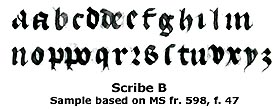 In
contrast to the work of Scribe A, Scribe B's script is smaller, more compact,
and angular. The letter "y" used by this scribe
can easily be distinguished from that of Scribe A by
the hairline descender which loops upwards to the right and the stroke
above which descends from the left
to the right. This scribe's "g" has a descender
which is frequently joined with the upper part of the
letter and
is placed off-center to
the right. Scribe B fills out empty spaces at the end
of lines with a pronounced
minim
stroke crossed by a dash and a dot beneath it.
In
contrast to the work of Scribe A, Scribe B's script is smaller, more compact,
and angular. The letter "y" used by this scribe
can easily be distinguished from that of Scribe A by
the hairline descender which loops upwards to the right and the stroke
above which descends from the left
to the right. This scribe's "g" has a descender
which is frequently joined with the upper part of the
letter and
is placed off-center to
the right. Scribe B fills out empty spaces at the end
of lines with a pronounced
minim
stroke crossed by a dash and a dot beneath it.
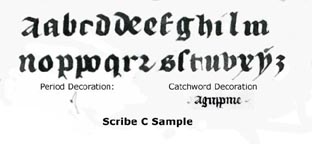 The
work of Scribe C has the appearance of being more fluid and more hastily
written than that of the other
scribes. The "y" has
a hairline dash which ascends from the left to the right. This copyist's letter "s" is
typically closed with the lower part being more pronounced. The "a" created
by this scribe is characteristically closed. Period
marks, especially if they appear at the end of a line,
have pronounced
hairline
tails. Like Scribe
A,
Scribe C decorates his catchwords with distinctive
decoration which is again almost
a signature for this scribe's work.
The
work of Scribe C has the appearance of being more fluid and more hastily
written than that of the other
scribes. The "y" has
a hairline dash which ascends from the left to the right. This copyist's letter "s" is
typically closed with the lower part being more pronounced. The "a" created
by this scribe is characteristically closed. Period
marks, especially if they appear at the end of a line,
have pronounced
hairline
tails. Like Scribe
A,
Scribe C decorates his catchwords with distinctive
decoration which is again almost
a signature for this scribe's work.
The work of these three scribes can be found in more than one copy of the Boccaccio text. Scribe A and Scribe C worked on all three copies, while Scribe B limited activity to MS fr. 598 and MS 9509. Usually the scribes were responsible for the rubrics and running-titles on pages which they transcribed, but exceptions suggest the distinction in stages between the transcription of the text and the addition of rubrics and running-titles. In MS fr. 598, the rubrics and running-titles in Scribe B's portions were written by Scribe A, while in MS 9509, Scribe C transcribed the rubrics and running-titles for Scribe A's stint.
Closer examination of the division of labor between
these scribes in relationship to the physical structure
of
the manuscripts
gives important
insights into
the production of these books. Two types of scribal
break are evident. The first
type is represented by instances where there is
a change in scribes in the middle of a gathering or even between
a recto
and verso of
a leaf.
Such breaks
suggest
consecutive copying with one scribe picking up
where another left off. The second type is represented by
instances where
there is a
break
in scribes after a short
gathering not containing the standard eight leaves,
or where there is a break
at the beginning of a gathering which introduces
a new text. This type of break suggests the division
of the
text into separate
scribal
units
which
could have
been distributed to the various copyists who could
have worked concurrently on the different scribal
units.
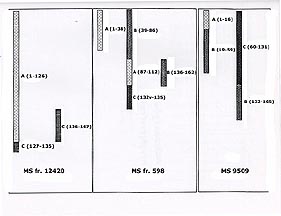 Diagramming these two types of scribal breaks gives
a better picture of the production of these
manuscripts. In the case
of MS fr. 12420,
Scribe A
was responsible for the whole manuscript up
to the recto of
folio 127.
Scribe C was responsible for the verso of this
leaf and the remainder of the gathering.
Significantly this break occurs in a gathering
before a short quire of six leaves (fols. 130-135)
completing
a
scribal unit.
Scribe C
was responsible
for the entirety
of the next scribal unit which extends from
folio 136 to folio 167, the end
of the manuscript. This suggests that Scribe
C actually began activity with folio
136 and worked concurrently with Scribe A who
was completing a stint, and then for some reason Scribe
A suspended
work with Scribe C completing
the
unit, in
all probability after the last scribal unit
had been completed .
Diagramming these two types of scribal breaks gives
a better picture of the production of these
manuscripts. In the case
of MS fr. 12420,
Scribe A
was responsible for the whole manuscript up
to the recto of
folio 127.
Scribe C was responsible for the verso of this
leaf and the remainder of the gathering.
Significantly this break occurs in a gathering
before a short quire of six leaves (fols. 130-135)
completing
a
scribal unit.
Scribe C
was responsible
for the entirety
of the next scribal unit which extends from
folio 136 to folio 167, the end
of the manuscript. This suggests that Scribe
C actually began activity with folio
136 and worked concurrently with Scribe A who
was completing a stint, and then for some reason Scribe
A suspended
work with Scribe C completing
the
unit, in
all probability after the last scribal unit
had been completed .
In MS fr. 598, three distinct scribal units
can be defined. Scribe A was again responsible
for
the beginning
of the
manuscript. Here
this copyist's
first stint
was only the first 38 leaves. While Scribe
A was working on the first scribal unit,
Scribe B probably
began
the next unit
extending from
folio 39 to
folio 135. For some reason Scribe B suspended
activity on this unit on folio 86,
and then likely began work on the last scribal
unit extending from folios 136-162.
Scribe A, picking up for Scribe B in the
second scribal unit, was responsible for folios 87-112r,
while Scribe
C completed
this scribal
unit (fols.
112v-135). In MS 9509, there are only two
scribal units. Scribe A and Scribe B collaborated
on the first unit extending from folios 1-59,
with Scribe A responsible for only the first
18 folios.
While Scribes
A and
B were working
on this first
unit, Scribe
C probably began the second unit, transcribing
folios 60-131, while Scribe B reappears on
folio
132 and completes
the
manuscript (fols.
132-165).
Dividing a text up into discrete scribal
units with different scribes working concurrently
expedited the production
of a book. Comparing
the length of
the scribal units gives a rough estimate
of
the relative
amount of time it took to
transcribe the different copies of the
text. For example, the amount of time it took to
produce MS fr. 12420
corresponds to the length
of the first
textual
unit, assuming, as argued above, that the
first and second units were transcribed
concurrently. The amount
of time
it
took to produce
MS
fr. 598 is determined
by the second unit. This again assumes
that this unit was begun at the same time as the
first
unit,
and that
the
third unit
was written
concurrently
with the
second. For MS 9509, the estimate is based
on the second unit. Since the first unit
in
MS fr.
12420
is 135 leaves
and the
second unit
in MS fr.
598
is composed
of 97 leaves, it took 72% of the time to
transcribe MS fr. 598 as opposed to MS
fr. 12420. Comparably,
MS 9509,
which
has a longest
unit of 106
leaves, took roughly 79% as long to write as
MS fr. 12420. Recent studies allow us to conjecture
an approximate
number
of days it
took to complete
the scribal
work on the respective
manuscripts. Donal Byrne, in a study of a Sallust
manuscript in Geneva, interpreted a set of
roman numerals at the
bottom of leaves to be
records of the days
it took to write the manuscript. He concluded
that the scribe completed between 3 and 3.5
leaves per
day. Since
this manuscript
is similar
to the Boccaccio
manuscripts
in format and script, the scribal work of MS
fr. 12420 could have taken between 38 and 45
days, that
of MS
fr. 598 between
28 and 32
days,
while that of
MS 9509 between 30 and 35 days.
THE SECONDARY DECORATION
The conclusions reached in the study of
the scribal activity are closely paralleled
in
an examination
of the secondary
decoration. The decorative
plan of the manuscripts,
like the lay-out of the page, reflects
the standardization of the
Parisian book industry. Each new text
is introduced by a large gold ground foliate
initial.
Along the margin adjacent to the large
initial runs a bar staff with painted
and gold rinceaux
sprouting
along
its
length and
at the top
and bottom
of the page. Dentelle paragraph marks
appear in the body of the text. This decorative
plan can be found in a number of books
produced in Paris during this period.
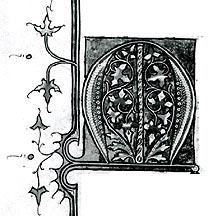
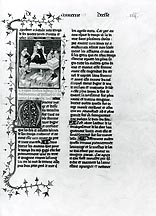 Closer
examination reveals the significant relationships between the three copies
of the text. I have
demonstrated elsewhere the ability to isolate
the contributions
of individual decorators. Although
unity and coherence of decorative
plans were
essential concerns for
decorators, a division of
labor can
be articulated
on
the basis of identifying distinct
repertoires of motifs and characteristic treatments
of decorative components.
Such an
examination of the
decoration of the Boccaccio
manuscripts reveals the work of six
distinct decorators.
Of
the decorators, the one here labelled
as
the A Decorator is
clearly
the finest.
His work is distinguished by the
delicacy of the treatment of the
various decorative components, most
apparent in the white highlighting
of bodies of the gold ground
foliate initials and of the dentelle
paragraph marks and line endings.
This delicacy is also apparent in
the thin pen line used in the stems
and tendrils of the penned
line rinceaux and the outlines of
the initials and of the painted rinceaux
leaves.
Closer
examination reveals the significant relationships between the three copies
of the text. I have
demonstrated elsewhere the ability to isolate
the contributions
of individual decorators. Although
unity and coherence of decorative
plans were
essential concerns for
decorators, a division of
labor can
be articulated
on
the basis of identifying distinct
repertoires of motifs and characteristic treatments
of decorative components.
Such an
examination of the
decoration of the Boccaccio
manuscripts reveals the work of six
distinct decorators.
Of
the decorators, the one here labelled
as
the A Decorator is
clearly
the finest.
His work is distinguished by the
delicacy of the treatment of the
various decorative components, most
apparent in the white highlighting
of bodies of the gold ground
foliate initials and of the dentelle
paragraph marks and line endings.
This delicacy is also apparent in
the thin pen line used in the stems
and tendrils of the penned
line rinceaux and the outlines of
the initials and of the painted rinceaux
leaves.
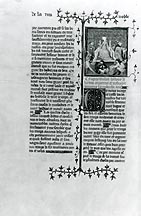
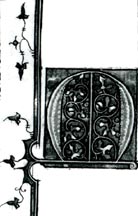 The
high quality of the A Decorator becomes immediately apparent
by comparing
the work by this craftsman to that
of the B Decorator,
whose white highlighting of the initials and
of the dentelle paragraph marks
and line endings is more simplified in
the repertoire of decorative
motifs. The painted lines lack
the control and delicacy of those of
the A Decorator. The pen line of
the B Decorator is thicker and
lacks the subtlety of that of
the A Decorator. This can be seen
in the more angular cusps created
by the ink outlining of the initials,
and the less fluid stems and tendrils
of the penned
line rinceaux.
The
high quality of the A Decorator becomes immediately apparent
by comparing
the work by this craftsman to that
of the B Decorator,
whose white highlighting of the initials and
of the dentelle paragraph marks
and line endings is more simplified in
the repertoire of decorative
motifs. The painted lines lack
the control and delicacy of those of
the A Decorator. The pen line of
the B Decorator is thicker and
lacks the subtlety of that of
the A Decorator. This can be seen
in the more angular cusps created
by the ink outlining of the initials,
and the less fluid stems and tendrils
of the penned
line rinceaux.
The general appearance of the work of the C Decorator is finickier and more cramped (Fig. 15), most apparent in the pen line employed by this decorator. The stems of the penned line rinceaux are frequently broken up by curls and dashes, while the outlining of the painted rinceaux creates more pronounced cusps.
The tendrils projecting from the stems of the penned line rinceaux are signatures for the work of the D Decorator (Fig. 16). These are formed by a pronounced curl usually followed by a loose "S" shaped curve. This decorator frequently includes a dragon projecting from the top of the bar staff.
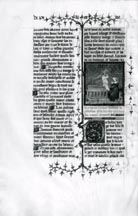
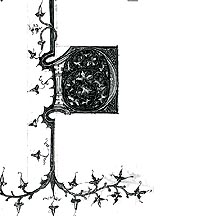 The
general aspect
of the E Decorator
suggests a rapidity of execution, perhaps
most apparent in
the tendrils of the penned
line rinceaux generally
formed by a comma stroke
followed by a quick "2" shape.
Clusters of gold
balls with the
distinctive
tendril decoration
frequently appear
in the borders
associated with
this hand.
The E Decorator
also creates denser
clumps
of painted
rinceaux from
which frequently
projects a gold
tongue
shape.
The
general aspect
of the E Decorator
suggests a rapidity of execution, perhaps
most apparent in
the tendrils of the penned
line rinceaux generally
formed by a comma stroke
followed by a quick "2" shape.
Clusters of gold
balls with the
distinctive
tendril decoration
frequently appear
in the borders
associated with
this hand.
The E Decorator
also creates denser
clumps
of painted
rinceaux from
which frequently
projects a gold
tongue
shape.
The F Decorator typically adds trilobed painted leaves in a concave space created by the bar staff adjacent to initials. The decorator also increases the number of cusps in the ink outlining of the staffs and initials. The gold leaves of this decorator are also typically thinner than those of the other decorators. The concave space left on the right side of paragraph marks are distinctive of this decorator's contributions.
The following tables identify the contributions
of
these distinct decorators:
The decoration of MS fr. 12420 was the responsibility of the A, B, and E Decorators, while five decorators worked on MS fr. 598 ( A, B, C, D, and E Decorators) and two decorated MS 9509 (B and F Decorators). Only the B Decorator worked on all three copies of the text, while the A and E Decorators worked on both MS fr. 12420 and MS fr. 598. The three other decorators (C, D, and F Decorators) contributed to only one of the copies. The collaboration of some of the decorators in multiple copies of the text reaffirms the conclusion reached in the discussion of the scribal activities that the different manuscripts are linked in their process of production. Since there is no correlation between the work of specific scribes and decorators, there is no evidence to conclude that any of the scribes also acted as a decorator.
The
division
of
labor
in
the
decoration
gives
a
better picture
of
the
production
of
the
books.
In
the
majority
of
cases
a
single
decorator
was
given
responsibility
for
the
decoration
of
a
gathering. It
seems,
especially
in
the
early
stages
of
production,
groups
of
gatherings
were
turned
over
to
a
decorator
at
a
single time.
For
example,
in
MS
fr.
598,
the
A
Decorator was
given
the
first
three
gatherings,
while
the
B
Decorator
was
given
the
next
nine
gatherings.
The
decorators
could
have
worked
concurrently
on
their
stints.
In
the
latter
portions
of
MS
fr.
598,
the
division
of
labor
is
more
complex.
With
the
gathering
beginning
on
folio
95,
decorators
appear
to
have
been
given
individual
gatherings
with
the
C,
B,
and
D
Decorators
each
being
given
a
single
gathering.
The
pattern
in
MS
fr.
598
becomes
more
complicated
with
the
gathering
beginning
on
folio
119
where
as
many
as
three
different
decorators
participated
in
the
decoration
of
an
individual
gathering.
Here
the
division
of
labor
is
by
bifolio.
It
is
noteworthy
that
in
these
latter
portions
of
MS
fr.
598
appear
the
only
contributions of
our C
and D
Decorators
in the
Boccaccio
manuscripts.
This
suggests
that
the
makers
of MS
fr. 598
were
under
pressure
to complete
the
manuscript
as soon
as possible,
necessitating
the
more
complicated
pattern
of the
division
of labor
and the
appearance
of these
other
decorators
who were
apparently
called
in to
help
speed
up the
process
of production.
These
conclusions
parallel
those
we
have
already
reached
in our
discussion
of the
division
of labor
in
the scribal
activity.
In
contrast to
MS fr.
598, the
division of
labor of
MS 9509
is much
simpler. Here,
only two
decorators participated
with each
apparently being
given groups
of gatherings
at a
single time.
The way
the B
and F
Decorators leap
frog through
the manuscript
suggests that
they were
working concurrently
with each
other and
with the
scribes. Groups
of gatherings
could be
parcelled out
to the
decorators as
the scribes
completed their
work on
them. The
decoration of
MS fr.
12420 presents
an intermediate
case between
the apparently
hectic pace
of MS
fr. 598
and the
leisurely one
of MS
9509. The
three decorators
divided their
labor by
groups of
gatherings in
the early
stages of
production. It
is only
with the
gathering beginning
on folio
114 that
a more
complex pattern
becomes apparent
with decorators
dividing the
labor by
bifolios.
THE
MINIATURE CYCLES
As
noted earlier,
MS fr.
12420, MS
fr. 598,
and MS
9509 were
dominated by
distinct artistic
personalities. In
contrast to
the other
stages of
production, there
is no
evidence of
individual miniaturists
working on
more than
a single
copy of
the Boccaccio
text. Acknowledging
this, the
striking similarities
in the
selection and
composition of
scenes in
corresponding miniatures
in the
various copies
of the
text needs
to be
explained. Instead
of concentrating
on the
issue of
miniature style,
the focus
here will
be on
a comparison
of the
different miniature
cycles and
their relationship
to the
texts they
illustrate.
The
relationship between
text and
image can
be demonstrated
by considering
the illustrations
associated with
the story
of the
infamous Olympias,
wife of
Philip of
Macedon and
the mother
of Alexander
the Great
(Figs. 1,
2, & 3).
The miniatures show
the crowned figure
of Olympias, wearing
a wimple and
being supported
by two women,
while armed
figures approach
Olympias. This
illustrates Boccaccio's
account of how
the jailed
Olympias, aware
of the approaching
executioners, prepared
herself and with
the assistance
of two servants
stood fearlessly
to face her death.
The miniatures include
a pile of bodies
among which
can be seen
a crowned figure.
This detail
demonstrates how
different moments
in the narrative
are combined.
Earlier in
the text, Boccaccio
tells how Olympias,
who had been
spurned by her
husband Philip
for committing adultery,
had
urged Pausanias,
her lover,
to kill Philip.
After Pausanias
had been executed
for the assasination,
Olympias had
his body placed
over the remains
of King Philip.
The three
miniatures, thus,
visualize the story
in the same
way even to the
point of
conflating different
episodes of the
account. But
comparison
of corresponding figures
in
the different
manuscripts suggests
no evidence
of dependence on a
common visual
model. The correspondences
evident
in the
Olympias miniatures are
characteristic of the
relationship
between the miniature
cycles in the three copies.
Even
when the
text does
not articulate
a particular
scene, the
conception of
the miniatures
is the
same. This
is exemplified by the
illustrations opening
the text
dedicated to
Minerva. The text enumerates Minerva's
various gifts: the art of wool (how it should be cleaned, softened
with a comb, placed on a distaff and spun with the fingers, and
woven); the pressing of olives
for oil; the invention of the cart; how to make iron weapons; the
use of armor; the strategy for soldiers and rules of battle; the
use of numbers; and the creation
of the flute. Each miniature shows Minerva seated on a throne with
figures illustrating her various gifts encircling her. Comparing
the list of gifts enumerated by the
text to those illustrated reveals significant variations. None
of the miniatures illustrate either the invention of the cart or
the strategy and rules of battle.
The miniatures conflate the creation of iron weapons and the use
of armor by showing a man beating a helmet on an anvil, and all
visualize the use of numbers
by showing a money-changer at his counting desk. There are differences
between the miniatures. In MS fr. 12420, Minerva is represented
without a crown and halo,
and
the art of wool is represented
by a single figure separating
wool. In contrast, both
MS fr. 598 and MS 9509
represent Minerva as crowned
and haloed,
and the art of wool is
represented by a woman
combing wool and a man
weaving.
These differences,
however, do not
override the striking
similarities between
the miniatures, and,
as will be
argued later,
these variations
possibly reflect
a revision in the
program
of the
illustrations.
Differences
in the
placement and
poses of
the figures
in the
corresponding miniatures
argue against
the use
of a common visual
model. The
relationship between
the different
miniature cycles
is best
explained by
their dependence
on a
common written
model. It
was a
common practice
to provide
miniaturists with
written directions
for miniatures.
In margins
adjacent to
miniatures in
a number
of manuscripts
erased instructions
can be
found. We
also have
the famous
case of
the pictorial
program that
Jean Lebègue wrote for the illustration of Sallust's Conspiracy
of Catiline and Jugurthine War. Another example is presented by what Gilbert
Ouy has identified as a maquette or manuscript model for luxury copies of the
text. This is a paper copy of Honoré Bouvet's
Somnium
super
schismatis, where
marginal notes
provide instructions
for the addition
of miniatures.
Although
in most
cases the
miniatures correspond
well with
the texts
they illustrate,
cases can
be found
where particular
miniatures are inconsistent with
the text
and disagree
with other
versions of
the pictorial
cycle. An
example of
this is
the miniature
in MS
fr. 598 accompanying
the
story of
Polyxena. The
text describes
how the
son of
Achilles, Neoptolemus,
revenges his
father's death
which had
innocently been
caused by
Polyxena.
The
story recounts
how Neoptolemus
slays Polyxena
by the
tomb of
Achilles. The
miniatures in
both MS
fr. 12420
and MS
fr. 598
show
the
son wielding
a sword
over the
figure of
Polyxena who
kneels by
a tomb.
In MS fr. 598,
however, instead
of showing a closed
tomb which
would have
been consistent
with the text,
an empty
tomb is depicted
with its lid
ajar. Without knowledge
of the
text it would
be natural to assume
that the
coffin was intended
for Polyxena.
We can imagine
this type
of assumption being
made by a
miniaturist who did
not consult
the text but followed
instructions that
called for Polyxena
to be represented
kneeling by a tomb.
The
miniature of
Veturia in
MS fr.
12420 presents
another instance
of a
miniaturist's probable
misinterpretation of
written instructions.
The narrative
tells how
Veturia's son,
Coriolanus, had
been exiled
from Rome
and fled
to the
Volscians. In
time, he
became the
commander
of
the Volscian
army which
he led
in a
war against
his native
Rome. After
Volscian victories,
the
Romans
sent three
embassies to
Coriolanus
to
sue for
peace. In
each case,
Coriolanus rebuffed
the
Roman
appeals. The
Roman matrons
turned to
Veturia
in
hopes that
she
could
persuade her
son. Veturia,
along with
Coriolanus' wife
and his
children, went
to the
Volscian camp,
and there
made an
impassioned appeal
to
Coriolanus.
In general
terms, all
three miniatures
visualize the
confrontation between
Veturia
and
Coriolanus in
the
same
way. The
miniatures are
divided
in
two groups,
one showing
Coriolanus before
his army
and the
other having
Veturia as
the principal
figure.
However,
MS fr.
598
and
MS 9509
are much
closer to
the
details
of the
narrative.
The
text describes
Veturia
as being
old and specifies
that
she was
accompanied by Coriolanus'
wife
and his children.
While
MS fr.
598
and MS
9509 are consistent
with
the
text
in these
details, MS fr.
12420 does
not represent Veturia
clearly
as an
older woman
and her companions
are not clearly
specified as
Coriolanus'
wife
and
children.
But most
significantly, the miniature
in
MS fr. 12420
misinterprets the confrontation
between
Veturia and Coriolanus.
It
is Veturia's
speech which
is
the
central
point of the
account. In both
MS fr. 598 and
MS 9509, the gestures
indicate
that
Coriolanus is listening
to
his mother's
appeal.
In
these miniatures,
Veturia uses
a
pointing
gesture while
Coriolanus' hands
are raised with
his palms placed
outwards, the
conventional gesture
of
someone
listening. In the
case
of
MS fr. 12420,
however,
the
gestures are reversed.
Coriolanus
is
shown ticking
points off on
his fingers, while
Veturia has her
hands raised
as if listening
to Coriolanus' speech.
Anyone
familiar
with the text
would
not
make
this critical
error. Again,
a miniaturist misinterpreting
written
instructions or imprecise
instructions
explain
such
inaccuracies. An
instance like this
strongly
argues against
the possibility mentioned
by others
that the miniatures
of the later
copies of
the text
were based
on the miniatures
of MS fr. 12420.
Again,
the dependence on a
common model,
verbal as opposed
to visual, is the
most satisfactory
explanation.
Although
misinterpretations
of
verbal instructions
can account
for many
of the
inconsistencies between
the different
miniature cycles,
there are
instances where
differences do
occur between
corresponding miniatures
which can
not be
explained by
miniaturists misrepresenting
the
instructions. This
is exemplified
by the
miniatures in
MS fr.
12420 and
MS fr.
598 which
accompany the
story of
Opis.
In MS fr. 12420,
Opis
sits in
a building with
three men kneeling
before her,
while in MS
fr. 598 Opis,
seated in a
temple, gestures
to three statues
placed on pedestals.
Comparison to the
text suggests
that both
miniatures are consistent.
The text
tells how an
image of Opis
was brought to
Rome,
and
was placed in a
noble temple.
The Romans
and Italians honored
the image
for many years
in a variety
of manners and ceremonies.
This
clearly explains
the miniature in MS
fr. 12420,
while earlier
in the text,
it is noted
that the
fame of Opis
is largely
due to her
rescue of her
three
sons,
Jupiter, Neptune,
and Pluto, and their
father
Saturn from
Titan's plans
to kill them.
This linking
of the veneration
of Opis with
that of her
sons is
represented in MS
fr. 598 by having Opis
gesture
to the three
statues, presumably
representing Jupiter,
Neptune, and Pluto.
MS fr. 598 image is not available |
Another
example of
this type
of disagreement
between the
miniature cycles
is represented
by the
second to
last miniature
in the two Paris
manuscripts.
The story of Camiola
tells how after
a sea battle
a certain Roland
was held
as a prisoner.
While Roland's
brother refused
to pay the ransom,
Camiola, a woman
of great wealth,
took pity
on Roland languishing
in prison. She realized
to have him released
she needed
to marry him
and pay the
ransom. The text
tells how Camiola
secretly sent
someone to Roland
to seek
his consent to her
proposal. With
his approval,
Roland and Camiola
were married
by proxy through
the mediation
of a procurator
with the
pledging of
a ring. Camiola
immediately sent
the ransom of two
thousand ounces
of silver to Roland
to have him
released. The
text does
not indicate
that Camiola
and Roland met until
after they
were married
and the ransom
had been paid.
The miniature of MS
fr. 12420
represents Roland
inside
the
prison holding
the hand of
Camiola who stands
outside while
a servant offers
the ransom
to another
man.
Although disagreeing
with the
letter of the
text which
refers to Camiola
and Roland
being married
by proxy, this
miniature is still
consistent with
the spirit of the
text with
the joining
of hands signifying
the marriage
while Roland
was in prison.
In the case
of MS fr.
598, the miniature
is much more
consistent
with
the letter
of the
text.
In
this illustration
Camiola is
represented standing
alone on
the right
side
of the miniature
while her servant,
holding the
ransom offers
Camiola's
proposal
to Roland
inside
the prison.
Since
the Opis
and Camiola
miniatures are
consistent to
at least
the spirit
if not
the letter
of the
text, the variations can
not be
attributed to
miniaturists misinterpreting
verbal
instructions. Also
our knowledge
of book
making practices
suggests that
it would
be extremely
unlikely that
the miniaturists
made these
revisions independently.
These variations
most probably
reflect a
revision in
the pictorial
program. One
can imagine
a planner,
once MS
fr. 12420
was completed,
deciding to
make minor
revisions in
the pictorial
program. Being
aware of
the inconsistency
between the
text and
miniature in
the Camiola
miniature in
MS fr.
12420, he
could have
revised his
instructions to
produce the
corresponding miniature
in MS
fr. 598.
At the
same time,
the planner
might have
made minor
revisions in
other miniatures.
The crown
and halo
could have
been added
to the
Minerva miniature
at the
same time
adding in
the same
miniature the
woman combing
wool and
the man
weaving. The
type of
revisions in
miniature cycles
found in
the Boccaccio
manuscripts parallels
the variations
Sandra Hindman
has identified in her analysis
of the early copies of Christine de Pizan's Epistre
Othéa.
As Hindman's
study
clearly
reveals,
miniaturists
did not
work independently,
but worked
under close
supervision.
Before
leaving
the
miniature
cycles,
I would
like
to
introduce
a
possible
example
of how
the illustrations
enhanced
a
reader's
understanding
of the
text.
This
is suggested
by Christine
de Pizan's use
of
these
manuscripts.
It is
well
known
that
Boccaccio's Des
femmes
noble
et renommées served as a principal source
for Christine's Livre
de
la
Cité des Dames, and Hindman has already determined
how Christine used miniatures in the Boccaccio manuscripts in the creation of
the pictorial cycle for her Epistre
Othéa.
At
least
one
example
can
be
identified
where
a
miniature
in
our
manuscripts
was
probably
used
as
a
source
in
Christine's
writings.
This
is
represented
by
the
miniatures
illustrating
the
account
of
Sempronia
which
show
her
embracing
a
man
while
behind
her
are
placed
a
variety
of
string
instruments
(Fig.
16).
The
text
recounts
the
richness
of
Sempronia's
intellectual
accomplishments.
It
notes
her
mastery
of
Latin
and
Greek
and
her
ability
to
write
verses.
She
was
also
an
accomplished
singer
and
dancer,
and
knew
how
to
play
all
instruments
(...Elle
savoit
de
tous
instrumens
jouer....).
Boccaccio
goes
on
to
note
how
Sempronia
used
these
abilities
as
instruments
of
sensuality
and
turned
to
wantonness.
Christine
includes
an
account
of
Sempronia
in
her
Cité des dames. Her account closely follows Boccaccio's listing
of the abilities of Sempronia except for a subtle, but I think a significant
difference. Whereas Boccaccio states that Sempronia was accomplished in all instruments,
Christine is more specific and states that Sempronia "...played all string
instruments so skillfully that she won every contest" (emphasis
added). The only
source of which
I am aware
which specifies
her mastery of string
instruments as opposed
to musical instruments
in general is represented
by the miniatures
of our Boccaccio
manuscripts.
This
suggests that
Christine de
Pizan did not
base her
borrowings
simply
on the text
of Boccaccio,
but she,
as has already
been demonstrated
by Hindman,
had access
to one of the
early
copies
of our French
translation.
Christine-
perhaps
used
both the
text and the miniatures
as
sources for
the
composition
of
her text.
CONCLUSIONS
All
stages
of
production from
the transcribing
of the
text,
through
the painting
of the
secondary
decoration,
to the
creation
of
the miniature
cycles
are
closely interconnected
in the
three earliest
extant copies
of the
Boccaccio
text.
All the
scribes
and
the majority
of the
decorators
collaborated
on multiple
copies, and
that, although
different miniaturists
were responsible
for the
pictorial cycles
in the
respective books,
their work
was apparently
based on
the same,
albeit at
times revised,
written instructions.
Such interconnection
raises important
questions about
the nature
of the
Paris book
industry. Undoubtedly
the various
specialists were
working under
common supervision.
Can it
be determined
who was
responsible for
coordinating production?
The question
of the
working relationship
of the
various makers
also needs
to be
examined. Were
they working
within the context
of
a workshop,
or were they working
independently?
Patrick
de Winter
has speculated
about the
role the
financier Jacques
Rapondi might
have played
in the
creation of
these Boccaccio manuscripts.
De
Winter has
gone as
far as
to say
that, at
least in
the case
of MS
fr. 12420,
Jacques Rapondi
directed the
project, and
he has
suggested that
Rapondi provided
Jean de
la Barre
with the
copy of
the text
which the
latter presented
to Jean
de Berry.
Further study
of the
Burgundian accounts
attest to
Rapondi's frequent
dealings with
the book
industry. Examination
of the
other extant
manuscripts clearly
associated with
Rapondi do
suggest interesting
correspondences. For
example, Scribe
A (Fig.
17) and
Decorators B
(Fig. 17)
and E
(Fig. 18)
contributed to
the production
of the
Livre
des
propriétés des Choses (Brussels, Bibliothèque
royale, MS 9094) which Jacques Rapondi sold to Philippe le Hardi in 1402, while
the A Scribe (Figs. 19-21) and the A (Fig. 19), D (Fig. 20), and E (Fig. 21)
Decorators appear to have collaborated on a copy of Hayton's Fleur
des
histoires
de
la
terre
d'Orient (Paris, Bibliothèque
nationale, MS fr.
12201), known
to be one
of three copies
Rapondi had completed
for Philippe le
Hardi in May
of 1403.
These instances
of repeated collaboration
support de Winter's
conclusion that
Jacques Rapondi
played a central
role in the
production of these
manuscripts, but I
question whether
Rapondi, considering
his other
activities, would
have been directly responsible
for coordinating production.
He perhaps
served as a
financial backer
for the
project, and left
the task of oversight to someone
else.
The
dealings of
another financier
Bureau de
Dampmartin present
possible parallels
to the
activities of
Jacques Rapondi.
Dampmartin served
as the patron of
Laurent de
Premierfait, who,
while living
in Dampmartin's
Paris "hotel", worked
on a French translation of Boccaccio's Decameron. This translation was subsequently
dedicated to Jean de Berry. The inventories of the Duke of Berry's collection
indicates that Dampmartin was an important source for new additions to the library.
François Avril has discussed the role Dampmartin played in the production
of at least one of these acquisitions. The Berry inventory of 1413 refers to
a "livre de Troye la grant" that Jean de Berry bought from Bureau de
Dampmartin in April of 1402. Avril has identified this manuscript as MS fr. 301
in the Bibliothèque nationale which, along with another copy, was copied
from a fourteenth-century Neapolitan manuscript of an Histoire
ancienne
jusqu'a
Cesar now in the British Library (Royal 20.D.I). This London manuscript contains
the following intriguing note on folio 8v: "Ci faut le secont cayer que
maistre Renaut doit avoir, qui baillé à Perrin Remiet pour faire
l'enluminure de l'autre cayer." Avril has convincingly identified the "maistre
Renaut" as Regnault du Montet, an important Parisian "libraire" of
the beginning of the fifteenth-century, and as Avril notes, Perrin Remiet was
an active "enlumineur" in
Paris at the
end of the
fourteenth and
beginning of
the fifteenth-century. As
Avril
has argued, in order
to make copies
of the London
manuscript, it was
unbound so that
different portions
could be distributed
to the scribes
and miniaturists involved
in the project.
Apparently, Regnault
du Montet
served as the
coordinator of
the production of the
copies, and
when the original
manuscript was
being rebound
after the
copies were
completed, the second
gathering was
found to be
missing. Unfortunately
there is no
clear documentary
evidence about
the relationship
between Regnault
du Montet and
Bureau de Dampmartin
in the production
of BN fr. 301.
It has
been assumed
that Dampmartin
purchased the manuscript
from Regnault
du Montet, but considering
the significant
financial outlay
involved in producing
such a manuscript,
the question
should be
raised whether
Regnault du
Montet acted
independently. Did Montet
carry out the
project with
the financial
backing of Bureau
de Dampmartin?
The roles of merchants
like Bureau
de Dampmartin and Jacques
Rapondi as middlemen
between authors
and/or manuscript makers and patrons
deserves closer study.
If
Jacques Rapondi
served as
the financial
backer of
the project,
this leaves
open the
question of
who took
direct responsibility for supervising
production. A
possible candidate
could be
the anonymous
author of
the translation.
Recent studies
of the
activities of
Christine de
Pizan have convincingly demonstrated
the strong
control she
had over
the production
of copies
of her
work. Reno
and Ouy
have demonstrated
that Christine
frequently acted
as a
scribe in
her own
manuscripts, and
Sandra Hindman's
study of
the Epistre
Othéa has convincingly
demonstrated the control Christine had over the creation of miniature cycles
that illustrate her texts. The author of the translation would be the most logical
person to have had the responsibility of devising and then revising the pictorial
program. Study of various copies of Christine's texts shows that she regularly
corrected and revised her work as different examples were produced. As Hindman
has observed, the comparative importance of creating a miniature cycle is suggested
by noting that when we can identify the creator of a miniature cycle it is usually
a highly educated person. For example, Ouy, on the basis of paleographic evidence,
has identified the creator of the maquette of Bouvet's Somnium
super
schismatis as Jean Gerson, the principal Parisian theologian of the early fifteenth-century.
Likewise, the humanist and royal functionary, Jean Lebègue,
devised
the
pictorial
program
for
the
work
of
Sallust.
Add
Rouse and Rouse discussion of Raoulet d'orleans in the Vaudetar bible.
Another
possible
candidate
could
be
one
of the
scribes.
Documents
reveal
that scribes,
or écrivains,
regularly
were given
the responsibility
of coordinating
production.
Here Scribe
A is a possibility.
Scribe A
was responsible
for the beginning
portions
of each copy
of the Boccaccio
text, and
he also completed
the rubrics
and running-titles
for Scribe
B's stints
in MS fr.
598. It is
significant
to recall
that the
work of Scribe
A can be
identified
in the two
other extant
manuscripts
which Jacques
Rapondi provided
for Philippe
le Hardi
(Brussels,
Bibliothèque
royale, MS 9094 and Paris, Bibliothèque
nationale, MS fr.
12201). Since
he was the
sole scribe
of MS fr.
12201 and was
responsible for
the opening portions
of MS 9094,
he was likely
the principal scribe
for these
other projects.
Scribe A could
have been
Jacques Rapondi's
principal contact
with the
book industry.
Having the responsibility of
coordinating the
work of the
different specialists,
Scribe A could
also have
worked with
the anonymous
translator, who
is the likely
candidate responsible
for the creation
and revision of
the written
guides for the miniature cycles.
Another
question which
needs to
be explored
is the
relationship of
the various
makers of
the Boccaccio
manuscripts to
each other. Were the
artisans members
of an équipe , or were they independent craftsmen hired on an ad hoc basis
to make their contributions? The appearance of different miniature styles in
the respective copies suggests that the miniaturists at least were independent,
but what about the relationship of the scribes and decorators? The collaboration
of a number of the makers in other projects for Jacques Rapondi has already been
noted, and the work of these scribes and decorators can be found in a number
of other manuscripts. Text Figure 4 charts out the appearance of these specialists.
While there are examples of repeated collaboration, there is no consistent pattern
of collaboration. The examples of repeated collaboration probably suggest more
about the common supervision of different projects than the possible existence
of a single workshop. For example, Scribe C and Decorators A and B along with
other specialists shared in the responsibility of creating three copies of the
Bible
historiale (Brussels, Bibliothèque royale, MS 9024-9025; Paris,
Arsenal, MS 5057-5058; Paris, Bibliothèque
nationale,
MS
fr.
159).
These
correspondences
probably
indicate
that
these
manuscripts
were
produced
under
the
guidance
of
the
same
coordinator.
Although
a
more conclusive
answer
about the relationship
of
the
makers
needs
to
await
a
more
detailed examination
of
a
larger
group
of
manuscripts,
the
evidence
to
date
suggests that
the
different
specialists
did
not
work
in
a
shared
workshop,
but
rather
that
they
worked
independently.
Other
study has
suggested that
artisans did
work independently
and were
called in
on an
ad hoc
basis to
contribute to particular projects.
There is
also little
documentary evidence
for the
existence of
large workshops
that would
employ the
number of scribes and
decorators involved in the
production of
the Boccaccio
manuscripts. In
fact, documents
suggest that
workshops were
composed of
members of
a family
with the
addition of
maybe a
couple of
assistants. It
seems that
the book
industry depended
on the
close physical
proximity of
the shops
of the
various practitioners.
It is
well known
that artisans
involved in
book production
lived in
the neighborhood
near the
university, especially
on the
streets around
St. Severin.
The Pont-du-Notre
Dame and
the rue
Neuve de
Notre Dame,
adjacent to
the cathedral,
were also
popular locations
for workshops
involved in
the industry.
The collaboration
of Regnault
du Montet
and Perrin
Remiet in
the production
of copies
Histoire ancienne
jusqu'a Cesar
demonstrates how
the centering
of the
industry in
specific neighborhoods
facilitated the
participation of
several
shops in the
making of individual
manuscripts. Rent
records for Paris
from 1450-51
list as
a previous owner
of a
house on the
rue de la
Parcheminerie a Pierre
Remiot, perhaps
identifiable as Perrin
Remiet. Significantly
this house
was adjacent to one
which had belonged
to Regnault du Montet.
Standardization of
book making
practices such
as types of
scripts and
decoration also
facililated the coordination
of production
shared by independent
shops.
The
manuscript
industry,
thus,
demanded
a clear
articulation
and standardization
of the
discrete
specialties.
The success
of a practitioner
depended
on the ability
to conform
to the
standards of the trade
and to
work
effectively
with
the network
of interdependent
shops.
With
full
awareness
of
the
conjectural
nature
of
the
following
conclusions,
a
hypothetical
account
of
the
process
of
production of the
Boccaccio manuscripts
can be
proposed. Jacques
Rapondi, being
aware of
the growing
interests of
members of
the Valois
family in
such new
texts, could
have served
as the
patron of
the anonymous
translator just
as Bureau
Dampmartin was
the patron
of Laurent
de Premierfait
while the
latter was
producing the
French translation
of the
Decameron. By
giving such
a deluxe
manuscript to
the Duke
of Burgundy
as a
New Year's
present, Rapondi
was aware
that he
would not
only receive
a monetary
gift in
return, but
as a
token of
his allegiance
to Philippe
le Hardi,
such a
gift would
further his
other commercial
interests as
well. This
is implicit
in the
record of
Philippe le
Hardi's gift
of 300
francs to
Jacques Rapondi
for not
only the
presentation of
the Boccaccio
manuscript but
also for "...les bons services qu'il [Jacques Rapondi] lui
faiz chascun jour et espere que face ou temps avenir...." De
Winter
has
already
suggested
that
the
motivation
of
Jean
de
la
Barre
in
giving
a
copy of
the
text
to
Jean
de
Berry
was
directly
connected
to
his
hope
for
a
positive
resolution
of
the
legal
difficulties
he
was
facing.
In
completing
the
translation,
the
anonymous
author in
all
probability
produced
a maquette
comparable
to
the one
Gerson
produced
for the
Bouvet
text.
This model,
possibly
written
on paper,
would
have
provided
the
basic
lay-out
of the
text with
spaces
defined
for the
large
initials and miniatures
that introduce
each account.
In the
maquette's margins
adjacent to
the spaces
designed for
miniatures could
have appeared
the guides
for the
pictorial program.
The author
could then
have either
parcelled out
the work,
or could
have turned
the project
over to
an écrivain, possibly our Scribe A, who would have had the responsibility
of overseeing the work of the different specialists. In either case, the continued
involvement of the author in the production of the different copies is suggested
by the revisions we have observed in the pictorial cycles. The maquette seems
to have been divided into separate scribal units which were distributed to various
scribes who probably worked concurrently. When the writing of a group of gatherings
was completed, they could then be distributed to the decorators. Once the decorators
completed their work, the gatherings could then be given to the miniaturists
along with the pictorial guides. These guides could have been in the form of
the maquette created by Gerson, or they could have been on separate sheets like
those composed by Jean Lebègue
for the Sallust
text. The separate
stages of production
could have
been carried
out
concurrently
so
that
while
the
scribes
were
working
on
the later
portions
of
the
text,
the
decorators
and miniaturists
could
have
already
been
at work
on their
contributions.
Although considering our current state of knowledge significant questions about the nature of the manuscript industry need to be left without conclusive answers, the type of integrated study of the different stages of book production presented in this paper can provide valuable clues to the resolution of these questions. This type of research appears to be particularly rich in its implications. For the literary historian, it can provide a better picture of the creation and production of new texts. The art historian can gain a better understanding of the nature of the creative process involved in painting a new pictorial cycle. The economic historian can gain insights into the workings of a major medieval industry. While the historian can learn much about the role patronage played in the social and political life of the period.
